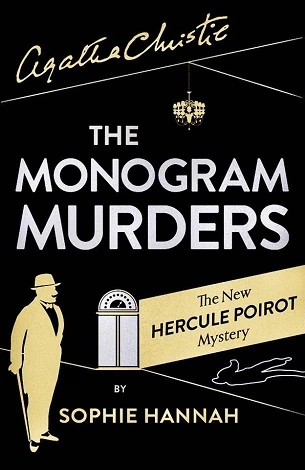Let me back up a minute and say that The Monogram Murders is not a horrible book and Sophie Hannah is, in her own right, an exceptional mystery author. However, when I read this book I wanted it to be another Murder on the Orient Express, Evil Under the Sun, or Death on the Nile and it wasn't because, let's be honest, there is only one Dame Agatha Christie.
The story starts out promising enough. While dining in Pleasant's Coffee House, Hercule Poirot encounters a frantic woman convinced that she is about to be murdered. The woman insists that death is nothing less than she deserves and before Poirot can unearth the details the woman runs from the restaurant. Later on at his boarding house Poirot learns from a fellow resident, who happens to be a detective with Scotland Yard, that three murdered bodies were discovered at the elegant Bloxam Hotel. Each body had a monogrammed cuff link in its mouth and an ominous note was left at the front desk stating "May they never rest in peace." Poirot instantly deduces that there is a link between the three murders at the Bloxam and the mysterious woman from Pleasant's Coffee House and he is determined to help Detective Catchpool solve the three murders before another occurs (after all, there must be a fourth murder since cuff links come in pairs).
Most of the problems that I have with The Monogram Murders stem from how vastly different Hannah's writing style is from Christie's. Agatha Christie is renowned for composing mysteries that are incredibly complex and wickedly clever. At the same time, Christie's writing is succinct and precise. There is never a word in an Agatha Christie book that does not need to be there. In contrast, Hannah's writing is much wordier and The Monogram Murders contains backstory, flashbacks, and excessive details that are jarringly UN-Christie like.
The disparity between Hannah and Christie is extremely evident when it comes to the narrator of The Monogram Murders, Detective Edward Catchpool. Now, it is nothing new for Poirot to have a sidekick, so to speak, that is not his intellectual equal. Just think of Hastings or Inspector Japp. What flummoxed me, though, was how Catchpool was so overwhelmed by the appearance of the bodies at the Bloxam that he abandoned the crime scene to return home for a bit of a lie down. Even Poirot was confused: "This evening? And yet you are here. Why are you not at the hotel? The killer, he is apprehended already?" What was Catchpool's response? "Don't worry, there are plenty of police crawling about the place...Tomorrow morning is soon enough for me to go back...I Had to clear my head." HUH! Wait a minute here, I thought Catchpool was an experienced detective with Scotland Yard? Yet, Hannah has him practically sprint from a crime scene because three bodies with no outward signs of physical injury freaked him out. Hannah elucidates throughout the book that Catchpool's discomfort with this particular crime scene stems from a childhood trauma, but this backstory was just odd and out of place in an Agatha Christie mystery.
 Ok, now I may just be being picky, but it annoyed me how often Hannah had Poirot talking about the "little grey cells". You are probably thinking: Why? Poirot is known for mentioning his little grey cells. Well, yes he is, but not every time he opens his mouth. Hannah references the little grey cells so frequently that it becomes more of an affectation. I began to feel like Hannah was trying to hammer it into my head that I really was reading about Hercule Poirot.
Ok, now I may just be being picky, but it annoyed me how often Hannah had Poirot talking about the "little grey cells". You are probably thinking: Why? Poirot is known for mentioning his little grey cells. Well, yes he is, but not every time he opens his mouth. Hannah references the little grey cells so frequently that it becomes more of an affectation. I began to feel like Hannah was trying to hammer it into my head that I really was reading about Hercule Poirot. The one good thing about The Monogram Murders was that I did not unravel the mystery before Poirot's big reveal. On the other hand, the mystery was so convoluted that I felt almost dizzy at the end and not in a good way. The motives and actions of everyone involved were far-fetched and unrealistic. Part of the magic of an Agatha Christie mystery is that after the culprit is denounced all the details snap perfectly into place and you are left wondering: "How did I not see that?" The ending of The Monogram Murders was an improbable, loopy mess that was a bit difficult to swallow.
I know I just ripped The Monogram Murders apart, but let me reiterate that it was far from being the worst book that I have ever read. My mistake was opening it up and wanting it be an Agatha Christie novel and that was never going to happen. As tempting as it is to have our favorite fictional characters resurrected in new books, it may be better just to go back and savor the originals.




No comments:
Post a Comment